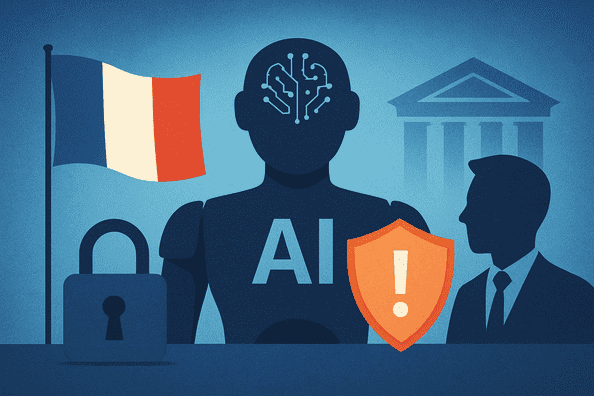In 2025, the AI diffusion rule in enterprise decision-making systems 2025 has become a pivotal topic for businesses worldwide. As artificial intelligence (AI) technologies evolve rapidly, enterprises are increasingly relying on AI to make critical decisions-from supply chain management to customer engagement. However, the diffusion of AI capabilities, especially advanced AI chips and models, is now governed by new regulations aimed at balancing innovation with security. This blog will explore the AI diffusion rule, its implications for enterprises, and how businesses can adapt their decision-making systems to thrive in this changing landscape.
What Is the AI Diffusion Rule in Enterprise Decision-Making Systems 2025?
The AI diffusion rule in enterprise decision-making systems 2025 refers to a regulatory framework introduced to control the export, use, and distribution of advanced AI technologies, particularly AI chips and model weights. This rule was designed to prevent sensitive AI capabilities from falling into the hands of adversaries or unauthorized entities, thereby safeguarding national security and technological leadership.
For enterprises, this rule means that AI-powered decision-making systems must now incorporate compliance protocols to ensure that the AI technologies they use or source adhere to these new regulations. It affects everything from procurement and vendor selection to internal AI governance and risk management.
The AI diffusion rule divides countries into tiers, each with specific licensing and export restrictions, which enterprises must navigate carefully. This tiered system influences global AI supply chains and the accessibility of cutting-edge AI technologies for businesses operating internationally.
Origins and Purpose of the AI Diffusion Rule
The AI diffusion rule emerged from growing concerns about the rapid proliferation of powerful AI chips and models, which could potentially be exploited by hostile actors or used in ways that threaten global security. The U.S. government, spearheading this initiative, aimed to establish a clear export control regime that balances technological innovation with national security interests.
The rule’s primary purpose is to regulate the diffusion of AI technology by:
- Preventing unauthorized access to advanced AI chips and models.
- Creating a tiered country system that categorizes nations based on their relationship with the U.S. and their compliance with export controls.
- Enforcing licensing requirements and validated end-user certifications to monitor and control AI technology flow.
For enterprises, understanding the origins and intent of this rule is crucial because it highlights the importance of compliance not just as a legal obligation but as a strategic necessity in the global AI ecosystem.
Key Components of the AI Diffusion Rule Affecting Enterprises
The AI diffusion rule consists of several core components that enterprises must understand to ensure compliance and optimize their AI decision-making systems:
- Tiered Country Classification: Countries are categorized into three tiers-each with different levels of access to advanced AI chips and models. Enterprises must know which tier their partners and markets fall into.
- Licensing Requirements: Exporting or importing AI chips and model weights often requires licenses, especially for high-performance components.
- Validated End User (VEU) System: Only certified entities can receive sensitive AI technology, necessitating enterprises to verify their partners’ VEU status.
- Due Diligence and Reporting: Enterprises must conduct thorough due diligence on suppliers and maintain records for audits and compliance reporting.
- Security Conditions: Strict controls on AI model storage, usage, and access to prevent unauthorized diversion or misuse.
By integrating these components into their AI decision-making workflows, enterprises can mitigate risks and ensure sustainable AI adoption.
Challenges Enterprises Face Under the AI Diffusion Rule
Adapting to the AI diffusion rule presents several challenges for enterprises:
- Complex Regulatory Landscape: Navigating the tiered country classifications and licensing requirements is administratively demanding.
- Supply Chain Visibility: Enterprises often struggle to obtain complete transparency about the origin and movement of AI chips and models in their supply chains.
- Technological Constraints: Some AI technologies may become inaccessible due to export restrictions, limiting innovation potential.
- Cost Implications: Compliance efforts require investments in legal counsel, compliance software, and training.
- Geopolitical Uncertainty: Changing international relations can affect the applicability and enforcement of the rule, complicating long-term planning.
Despite these challenges, enterprises that proactively address them can turn compliance into a competitive advantage by building trust with customers and regulators.
Table: AI Diffusion Rule Key Elements and Enterprise Implications
| AI Diffusion Rule Element | Description | Enterprise Implications |
| Tiered Country Classification | Countries divided into 3 tiers with varying access | Affects sourcing, partnerships, and market reach |
| Licensing Requirements | Licenses required for export/import of AI chips | Requires legal oversight and administrative effort |
| Validated End User System | Certification for trusted recipients | Necessitates vetting and partnership validation |
| Due Diligence and Reporting | Obligations for tracking and reporting AI assets | Increases compliance workload and documentation |
| Security Conditions | Controls on AI model storage and access | Demands enhanced cybersecurity and risk management |
Impact of the AI Diffusion Rule on Enterprise AI Strategy
The AI diffusion rule is reshaping how enterprises develop and implement AI strategies. The rule’s compliance requirements compel organizations to rethink their AI procurement, deployment, and governance processes.
Firstly, enterprises must prioritize transparency in their AI supply chains, ensuring that all AI chips and models come from compliant sources. This often means vetting vendors rigorously and adjusting procurement policies to align with export control laws.
Secondly, decision-making systems themselves need to embed compliance checks. For example, AI-powered analytics platforms must flag any AI components or datasets that could violate diffusion rules. This integration of regulatory compliance into AI workflows helps enterprises avoid costly penalties and reputational damage.
Finally, enterprises are increasingly adopting a risk-based approach to AI deployment, balancing innovation ambitions with regulatory constraints. This includes investing in internal compliance teams and AI governance frameworks that monitor AI diffusion risks continuously.
How AI Diffusion Rule Influences Supply Chain Management
Supply chain management is a critical area where the AI diffusion rule exerts significant influence. Enterprises must now ensure that every component of their AI infrastructure-from chips to software models-is sourced from compliant suppliers.
This means:
- Establishing end-to-end visibility over supply chains.
- Conducting supplier audits to verify compliance with export controls.
- Collaborating only with vendors who meet validated end-user criteria.
- Implementing traceability systems to track AI chip movement and usage.
These steps help enterprises avoid inadvertent violations and strengthen supply chain resilience against geopolitical disruptions.
Compliance Roadmap for Enterprises in 2025
To successfully navigate the AI diffusion rule, enterprises should follow a structured compliance roadmap:
- Step 1: Map AI Assets and Supply Chains
Identify all AI chips, models, and related technologies in use, and trace their origins and destinations. - Step 2: Classify Countries and Partners
Determine the tier classification of all countries involved in your AI ecosystem. - Step 3: Secure Necessary Licenses and Certifications
Apply for export licenses where required and verify the Validated End User status of partners. - Step 4: Implement Compliance Management Systems
Use software tools to automate due diligence, licensing tracking, and reporting. - Step 5: Train Teams and Stakeholders
Ensure that procurement, legal, and technical teams understand the AI diffusion rule’s requirements. - Step 6: Monitor and Audit Regularly
Continuously review compliance status and update policies as regulations evolve.
By following this roadmap, enterprises can reduce compliance risks and maintain agility in AI-driven decision-making.
The Role of AI Diffusion Rule in Global AI Governance
The AI diffusion rule is a cornerstone in the emerging global framework for AI governance. It exemplifies how governments are increasingly regulating AI not only based on ethical concerns but also through security and geopolitical lenses.
This rule encourages international cooperation by setting standards for AI technology transfer and usage. It also pushes enterprises to adopt best practices in AI transparency, accountability, and security, which are becoming global expectations.
Moreover, the AI diffusion rule signals a shift towards more nuanced AI governance models that balance innovation with control. Enterprises that align with these models will be better positioned to participate in international markets and collaborations.
Future Outlook: How AI Diffusion Rule Will Shape Enterprise Decision-Making Beyond 2025
Looking beyond 2025, the AI diffusion rule is expected to evolve in response to technological advances and geopolitical dynamics. The current administration is considering revisions to simplify the framework while maintaining security objectives.
Enterprises should anticipate:
- More Adaptive Compliance Requirements: Rules will likely become more flexible, incorporating AI risk assessments and usage contexts.
- Integration with AI Ethics Frameworks: Compliance will extend beyond export controls to include ethical AI use and data privacy.
- Increased Use of AI for Compliance: Enterprises will deploy AI tools to automate monitoring and reporting, enhancing efficiency.
- Greater International Harmonization: More countries may adopt similar diffusion rules, necessitating global compliance strategies.
In this evolving landscape, enterprises that embed AI governance deeply into their decision-making systems will gain resilience and competitive advantage.
Practical Tips for Enterprises Navigating AI Diffusion Rule in 2025
To thrive under the AI diffusion rule, enterprises should:
- Stay Updated on Regulatory Changes: Subscribe to government and industry updates related to AI diffusion.
- Leverage AI-Powered Compliance Tools: Automate due diligence, licensing tracking, and anomaly detection.
- Build Strong Vendor Relationships: Collaborate with suppliers who have validated end-user status and transparent supply chains.
- Document Everything: Maintain detailed records of AI chip procurement, usage, and compliance activities.
- Prioritize Cybersecurity: Protect AI models and data with robust access controls and encryption.
- Train Cross-Functional Teams: Ensure legal, procurement, and technical staff understand compliance requirements.
- Engage with Industry Groups: Participate in forums and consortia focused on AI governance.
These steps will help enterprises reduce risks and maximize the benefits of AI in decision-making.
Conclusion: Embracing the AI Diffusion Rule for Sustainable AI Growth
The AI diffusion rule in enterprise decision-making systems 2025 marks a significant turning point in how businesses adopt and govern AI technologies. While it introduces new compliance challenges, it also offers an opportunity for enterprises to build more secure, transparent, and responsible AI ecosystems.
By understanding the rule’s components, anticipating its impact, and implementing robust compliance strategies, enterprises can not only avoid legal pitfalls but also position themselves as leaders in the responsible AI revolution. The future belongs to those who balance innovation with security-and the AI diffusion rule is a key part of that journey.



